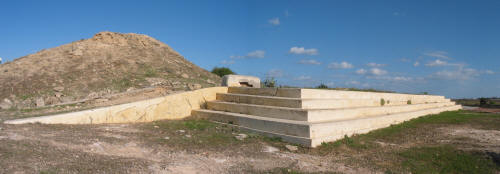Nicocreon Monument
Tuzla, Near Famagusta, North Cyprus
The Nicocreon monument can be found on the outskirts of the village of Tuzla, near Salamis.
Nicocreon was the King of Salamis at the time of Alexander the Great. When Alexander died in 323BC leaving no heir, Perdiccas, the leading cavalry commander, became regent, pending the arrival of Alexander's unborn child. Other cavalry generals became governors of areas of the empire. Ptolemy of Egypt (which covered Cyprus), and Antigonus of an area covering what we now would call central and southern Turkey.
 |
| The Nicocreon Monument |
In 322BC, Perdiccas' marriage to Alexander's sister led Ptolemy, Antigonus and the other generals to join in rebellion. During an invasion of Egypt, Perdiccas was, however, murdered by his own generals, and Ptolemy came to terms.
In 319BC, war broke out again, with Ptolemy and Antigonus once more allies. The end result left Antigonus in charge of the Asian territories of the empire.
Over the next few years, Antigonus grew more powerful, a situation that the other rulers eventually would not tolerate, and in 314BC, Antigonus and Ptolemy found themselves on opposing sides. Nicocreon now had to decide what way to go, and he decided to support Ptolomy. At some stage, however, he changed sides, a decision that cost him his life.
In 311BC, Ptolomy laid siege to Salamis. When Nicocreon realised that he had no chance of victory, he decided to commit suicide rather than surrender. When his queen heard of this, she killed her daughters in order to stop them falling the hands of their enemies. She then persuaded the wives of King Nicocreon's brothers to do the same, afterwards setting fire to the palace and taking her own life.
It is thought that this cenotaph was built in honour of their king and royal family. After lighting a symbolic fire on the platform, the cenotaph was covered with a 30ft high tumulus.
This was excavated in 1965. A circular platform was found, with steps on all four sides, with a ramp on the western side. In the centre of the platform, remains of wreaths, carbonised wood and clay statues were found.
See the location in Google maps.
Return to Salamis Index or Famagusta Index.